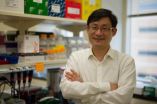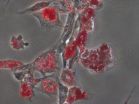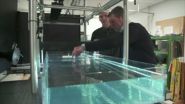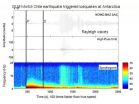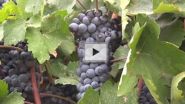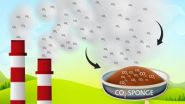(Press-News.org) INDIANAPOLIS -- Researchers have discovered a previously unknown cardiac molecule that could provide a key to treating, and preventing, heart failure.
The newly discovered molecule provides the heart with a tool to block a protein that orchestrates genetic disruptions when the heart is subjected to stress, such as high blood pressure.
When the research team, led by Ching-Pin Chang, M.D., Ph.D., associate professor of medicine at the Indiana University School of Medicine, restored levels of the newly discovered molecule in mice experiencing heart failure, the progression to heart failure was stopped. The research was published in the online edition of the journal Nature.
The newly discovered molecule is known as a long non-coding RNA. RNA's usual role is to carry instructions -- the code -- from the DNA in a cell's nucleus to the machinery in the cell that produces proteins necessary for cell activities. In recent years, scientists have discovered several types of RNA that are not involved in protein coding but act on their own. The role in the heart of long non-coding RNA has been unknown.
But the researchers determined that the newly discovered non-coding RNA, which they named Myheart -- for myosin heavy-chain-associated RNA transcript -- is responsible for controlling a protein called BRG1 (pronounced "berg-1"). In earlier research published in Nature in 2010, Dr. Chang and his colleagues discovered that BRG1 plays a crucial role in the development of the heart in the fetus.
But as the heart grows and needs to mature into its adult form, BRG1 is no longer needed, so very little of it is produced. That is, until the adult heart is subjected to significant stress such as high blood pressure or damage from a heart attack. Dr. Chang's previous research showed that in those conditions, BRG1 re-emerges and begins altering the heart's genetic activity, leading to heart failure. At the same time, production of Myheart is suppressed, so BRG1 can latch onto the DNA and alter the genetic material unchecked.
In the current Nature paper, the researchers reported that in mice with stress-induced high levels of BRG1, they were able to restore Myheart to normal levels using gene transfer technology. Restoring Myheart levels blocked BRG1 actions and prevented heart failure, they said.
"I think of Myheart as a molecular crowbar that pries BRG1 off the genomic DNA and prevents it from manipulating genetic activity," said Dr. Chang, director of molecular and translational medicine at the Krannert Institute of Cardiology.
Although the results in mice would suggest testing Myheart against heart failure in humans, it is too large -- by molecular standards -- to be delivered as a drug, Dr. Chang said.
So he and his colleagues now are working to identify smaller portions of the Myheart molecule that are key to its ability to block BRG1. Such a subsection of the Myheart molecule could lead to a compound to test in human trials.
INFORMATION:
In addition to Dr. Chang and Pei Han, Ph.D., first author of the paper, investigators contributing to the research included Wei Li, Jin Yang and Peng-Sheng Chen of the IU School of Medicine; Chiou-Hong Lin, Ching Shang, Sylvia T. Nuernberg, Kevin Kai Jin, Weihong Xu, Chieh-Yu Lin, Chien-Jung Lin, Yiqin Xiong, Huan-Chieh Chien, Euan Ashley, Daniel Bernstein and Thomas Quertermous of the Stanford University School of Medicine; Bin Zhou of the Albert Einstein College of Medicine; and Huei-Sheng Vincent Chen of the Sanford/Burnham Medical Research Institute.
The research was supported by the American Heart Association (AHA; Established Investigator Award 12EIA8960018); the National Institutes of Health (NIH; HL118087, HL121197, HL109512, HL105194, HL78931, HL71140, HL116997, HL111770); California Institute of Regenerative Medicine (CIRM; RN2-00909, RB2-01512, RB4-06276); Stanford Heart Center Research Program; the IU School of Medicine-IU Health Strategic Research Initiative; the IU Physician-Scientist Initiative, endowed by Lilly Endowment; the Lucile Packard Foundation for Children's Health; the March of Dimes Foundation (#6-FY11-260); the Oak Foundation; and the Baxter Foundation.
Newly discovered heart molecule could lead to effective treatment for heart failure
2014-08-10
ELSE PRESS RELEASES FROM THIS DATE:
Bioengineers: Matrix stiffness is an essential tool in stem cell differentiation
2014-08-10
Bioengineers at the University of California, San Diego have proven that when it comes to guiding stem cells into a specific cell type, the stiffness of the extracellular matrix used to culture them really does matter. When placed in a dish of a very stiff material, or hydrogel, most stem cells become bone-like cells. By comparison, soft materials tend to steer stem cells into soft tissues such as neurons and fat cells. The research team, led by bioengineering professor Adam Engler, also found that a protein binding the stem cell to the hydrogel is not a factor in the differentiation ...
Pairing old technologies with new for next generation electronic devices
2014-08-10
UCL scientists have discovered a new method to efficiently generate and control currents based on the magnetic nature of electrons in semi-conducting materials, offering a radical way to develop a new generation of electronic devices.
One promising approach to developing new technologies is to exploit the electron's tiny magnetic moment, or 'spin'. Electrons have two properties – charge and spin – and although current technologies use charge, it is thought that spin-based technologies have the potential to outperform the 'charge'-based technology of semiconductors for ...
Physicists create water tractor beam
2014-08-10
VIDEO:
Physicists at the Australian National University have created a tractor beam in water. Using a simple wave generator they can create water currents which could be used to confine oil...
Click here for more information.
Physicists at The Australian National University (ANU) have created a tractor beam on water, providing a radical new technique that could confine oil spills, manipulate floating objects or explain rips at the beach.
The group, led by Professor Michael ...
2010 Chilean earthquake causes icequakes in Antarctica
2014-08-10
VIDEO:
High-frequency icequakes are shown at station HOWD in Antarctica during the distant waves of the 2010 magnitude 8.8 Chile earthquake. The triggered icequakes are indicated by the narrow vertical bands...
Click here for more information.
Seismic events aren't rare occurrences on Antarctica, where sections of the frozen desert can experience hundreds of micro-earthquakes an hour due to ice deformation. Some scientists call them icequakes. But in March of 2010, the ice sheets ...
Target identified for rare inherited neurological disease in men
2014-08-10
Researchers at University of California, San Diego School of Medicine have identified the mechanism by which a rare, inherited neurodegenerative disease causes often crippling muscle weakness in men, in addition to reduced fertility.
The study, published August 10 in the journal Nature Neuroscience, shows that a gene mutation long recognized as a key to the development of Kennedy's disease impairs the body's ability to degrade, remove and recycle clumps of "trash" proteins that may otherwise build up on neurons, progressively impairing their ability to control muscle ...
The grass really is greener on TV and computer screens, thanks to quantum dots
2014-08-10
SAN FRANCISCO, Aug. 10, 2014 — High-tech specks called quantum dots could bring brighter, more vibrant color to mass market TVs, tablets, phones and other displays. Today, a scientist will describe a new technology called 3M quantum dot enhancement film (QDEF) that efficiently makes liquid crystal display (LCD) screens more richly colored.
His talk will be one of nearly 12,000 presentations at the 248th National Meeting & Exposition of the American Chemical Society (ACS), the world's largest scientific society, taking place here through Thursday.
"Green grass just pops ...
Pregnant women and fetuses exposed to antibacterial compounds face potential health risks
2014-08-10
SAN FRANCISCO, Aug. 10, 2014 — As the Food and Drug Administration (FDA) mulls over whether to rein in the use of common antibacterial compounds that are causing growing concern among environmental health experts, scientists are reporting today that many pregnant women and their fetuses are being exposed to these substances. They will present their work at the 248th National Meeting & Exposition of the American Chemical Society (ACS), the world's largest scientific society.
The meeting, which takes place here through Thursday, features nearly 12,000 presentations on a ...
Wine symposium explores everything you wanted to know about the mighty grape (video)
2014-08-10
San Francisco, Aug. 10, 2014 — Location. Location. Location. The popular real estate mantra also
turns out to be equally important for growing wine grapes in fields and storing bottles of the beverage at home or in restaurants, according to researchers.
Those are just two of the topics that will be covered in a symposium titled, "Advances in Wine Research," that will run today through Tuesday at the 248th National Meeting & Exposition of the American Chemical Society (ACS). The meeting features nearly 12,000 reports. A brand-new ACS video on the topics is available ...
Carbon dioxide 'sponge' could ease transition to cleaner energy
2014-08-10
SAN FRANCISCO, Aug. 10, 2014 — A sponge-like plastic that sops up the greenhouse gas carbon dioxide (CO2) might ease our transition away from polluting fossil fuels and toward new energy sources, such as hydrogen. The material — a relative of the plastics used in food containers — could play a role in President Obama's plan to cut CO2 emissions 30 percent by 2030, and could also be integrated into power plant smokestacks in the future.
The report on the material is one of nearly 12,000 presentations at the 248th National Meeting & Exposition of the American Chemical Society ...
On the frontiers of cyborg science
2014-08-10
SAN FRANCISCO, Aug. 10, 2014 — No longer just fantastical fodder for sci-fi buffs, cyborg technology is bringing us tangible progress toward real-life electronic skin, prosthetics and ultraflexible circuits. Now taking this human-machine concept to an unprecedented level, pioneering scientists are working on the seamless marriage between electronics and brain signaling with the potential to transform our understanding of how the brain works — and how to treat its most devastating diseases.
Their presentation is taking place at the 248th National Meeting & Exposition of ...
